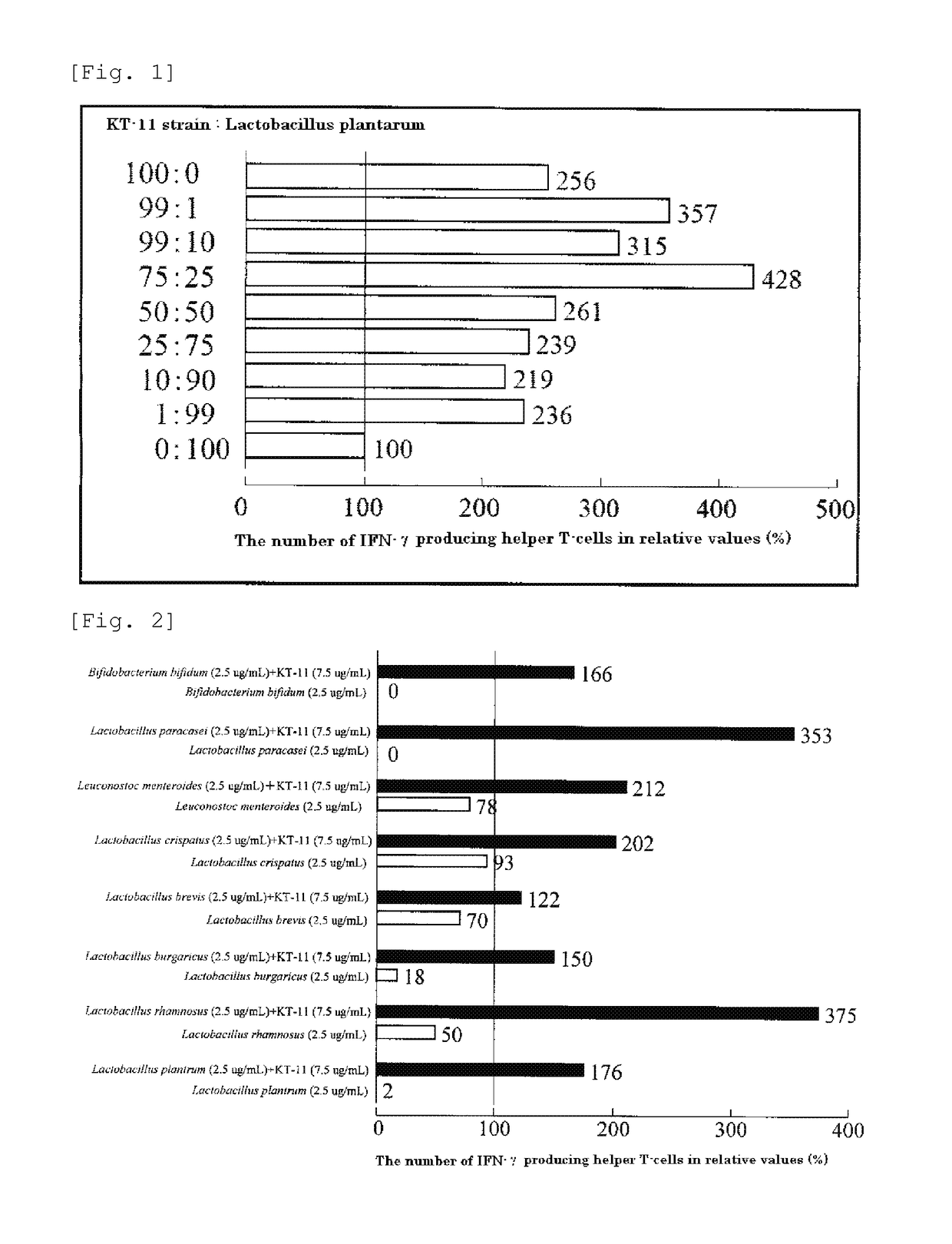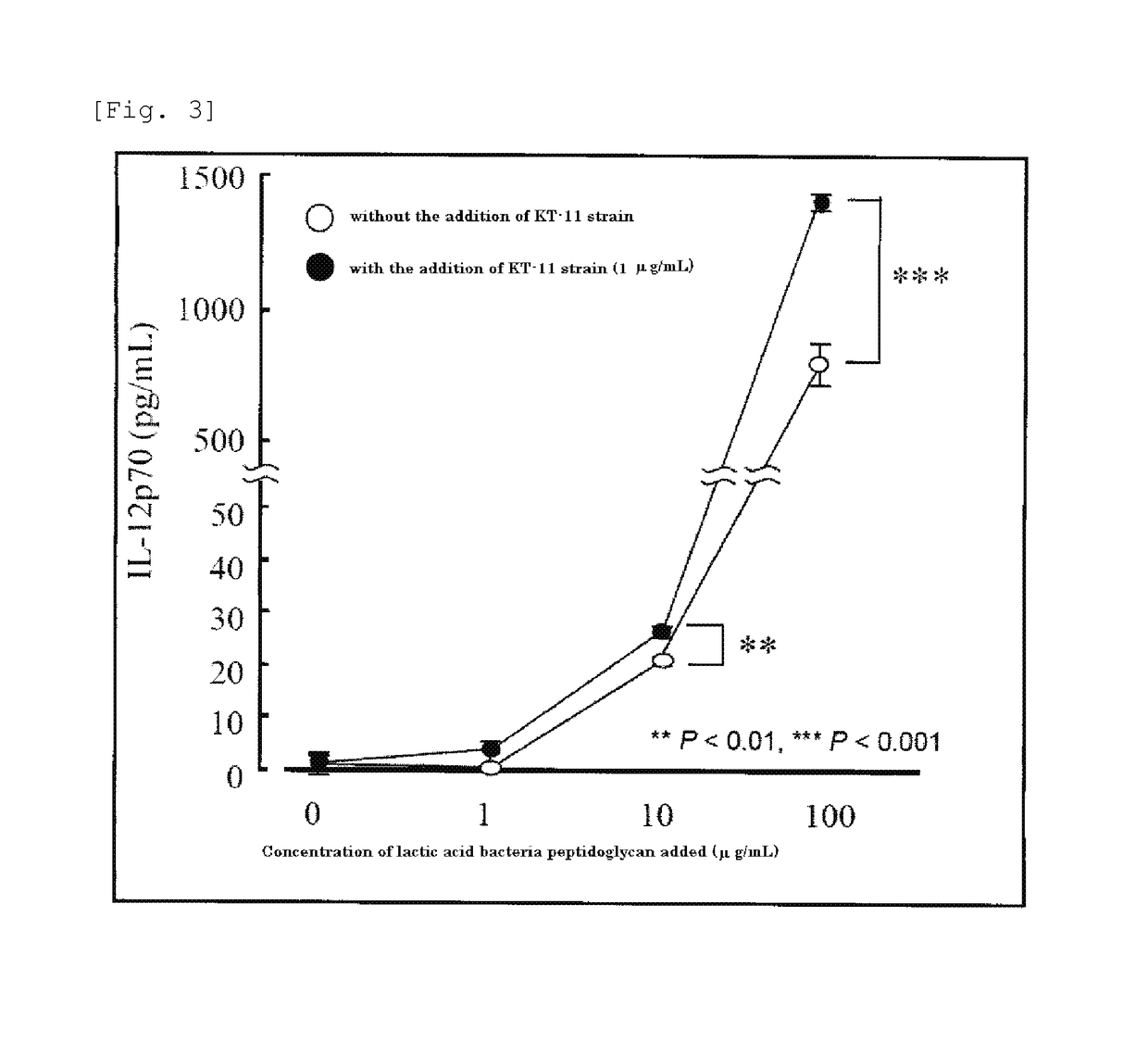Anti-allergic composition
a technology of composition and anti-allergic, applied in the field of anti-allergic composition, can solve the problems of drowsiness and thirst, and drugs are not always safe, and achieve the effect of improving the safety of drugs
- Summary
- Abstract
- Description
- Claims
- Application Information
AI Technical Summary
Benefits of technology
Problems solved by technology
Method used
Image
Examples
example 1
[0047](Synergistic Action on Anti-Allergic Effect Based on Difference in Addition Ratio)
[0048]It is shown hereinbelow the synergistic action of Lactobacillus crispatus KT-11 strain (FERM BP-11332) on anti-allergic effect based on the difference in addition ratio.
[0049](Preparation of Bacterial-Cell Sample Solution)
[0050]Lactobacillus crispatus KT-11 strain or Lactobacillus plantarum JCM 1149T was inoculated on an MRS liquid medium respectively, and cultured at 37° C. for 24 hours. After the culture, the bacterial cells were collected by centrifugation (2,000 rpm, 10 minutes) and washed three times with distilled water. The washed bacterial cells were lyophilized, then suspended and heat-treated (65° C., 30 minutes) in a sterile 0.15 M sodium chloride-0.01 M phosphate buffer solution (PBS, pH 7.2) to provide a bacterial-cell sample solution.
[0051](Preparation and Culture of Peyer's Patch Cell Suspension)
[0052]Intestinal Peyer's patch was removed from a 6 week-old male C3H / HeN mouse, ...
example 2
[0058](Advantage of Synergistic Action on Anti-Allergic Effect)
[0059]The synergistic action of Lactobacillus crispatus KT-11 strain on anti-allergic effect is shown below.
[0060](Preparation of Bacterial-Cell Sample Solution)
[0061]Test bacteria shown in Table 1 were prepared respectively in the same manner as in Example 1, and Lactobacillus crispatus KT-11 strain and each strain of the test bacteria were mixed at the ratio of 75:25 to provide bacterial-cell sample solutions.
[0062]
TABLE 1List of test bacteriaBifidobacterium bifidum NBRC14252TLactobacillus paracasei NBRC15889TLactobacillus bulgaricus JCM1002TLactobacillus plantarum JCM1149TLactobacillus crispatus JCM1185TLactobacillus rhamnosus ATCC53103Leuconostoc mesenteroides (Sceti)Lactobacillus brevis (Sceti)
[0063](Preparation and Culture of Peyer's Patch Cell Suspension and Change in the Number of IFN-γ Producing Helper T-Cells)
[0064]A Peyer's patch cell solution was prepared and cultured in the same manner as in Example 1. Subse...
example 3
[0066](Preparation of Bacterial-Cell Sample Solution)
[0067]Test bacteria shown in Table 1 were prepared respectively in the same manner as in Example 1 to provide bacterial-cell sample solutions.
[0068](Culture of Mouse Macrophage-Like Cell Line)
[0069]J774.1 cells, a mouse macrophage-like cell line, were used after suspended in a RPMI-1640 medium containing 5% FBS, 100 U / mL Penicillin G sodium and 100 μg / mL streptomycin sulfate, and cultured to confluence in a sterile plastic petri dish at 37° C. under 5% CO2. J774.1 cell suspension prepared at 1×106 / mL was aliquoted in 1 mL to a 48-well flat-bottom microplate, and 100 μL each of a bacterial-cell sample solution of Lactobacillus crispatus KT-11 strain prepared so that the final concentration was 0 or 1 μg / mL and a commercially available Lactobacillus acidophilus-derived peptidoglycan solution (Peptidoglycan type II, Wako Pure Chemical Industries, Ltd.) dissolved in PBS were added respectively to each well and cultured at 37° C. in th...
PUM
| Property | Measurement | Unit |
|---|---|---|
| pH | aaaaa | aaaaa |
| concentration | aaaaa | aaaaa |
| temperature | aaaaa | aaaaa |
Abstract
Description
Claims
Application Information
 Login to View More
Login to View More - R&D
- Intellectual Property
- Life Sciences
- Materials
- Tech Scout
- Unparalleled Data Quality
- Higher Quality Content
- 60% Fewer Hallucinations
Browse by: Latest US Patents, China's latest patents, Technical Efficacy Thesaurus, Application Domain, Technology Topic, Popular Technical Reports.
© 2025 PatSnap. All rights reserved.Legal|Privacy policy|Modern Slavery Act Transparency Statement|Sitemap|About US| Contact US: help@patsnap.com


